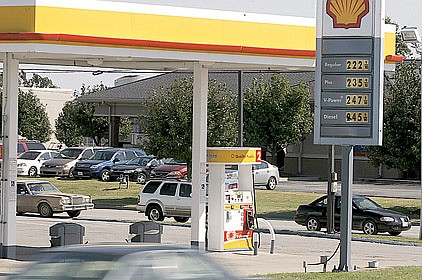LITTLE ROCK — The national average retail price for gasoline dipped below $2.50 a gallon for the first time in two months Monday as swelling oil supplies and slumping demand overshadowed even a fire at a major U.S. refinery.
Friday's fire at a Tesoro refinery in Los Angeles, which processes roughly 100,000 barrels of crude oil a day into gasoline, jet fuel and other products, will likely lead to some higher pump prices in California, but the effect is muted elsewhere, said analyst and trader Stephen Schork.
Gasoline demand is so weak that even "a material disruption to supply to one of the largest markets in the world barely registered with the speculators on the Nymex," Schork wrote, referring to the New York Mercantile Exchange.
The average price for a gallon of regular gasoline fell a half a penny overnight to place it at a tenth of a cent below $2.50, according to analysts at auto club AAA, Wright Express and Oil Price Information Service. That's 11 cents less than a month ago, and nearly $1.16 below what drivers were paying at this time last year.
In Arkansas, the AAA said, the average price of regular unleaded was $2.29, down a penny from Sunday and down 15 cents from a month ago. There was little variance from region to region in the state in Monday's price.
Crude oil supplies in the United States are 9 percent higher than the five-year average for this time of year, which should help keep gas prices relatively low. Oil supplies rose 2.86 million barrels, or 0.9 percent, to 335.6 million barrels in the week ended Sept. 18, in the biggest increase since July, according to the U.S. Energy Information Administration.
Still, energy prices for the most part rebounded to start the week on the Nymex, particularly crude, which had hit a two-month low on Thursday. The benchmark crude for November delivery rose 82 cents Monday to settle at $66.84 a barrel, but that's still a few dollars less than the average in recent weeks.
A couple of factors this week have given a small boost to gasoline futures prices, as the price for October delivery on the Nymex rose 1.75 cents to settle at about $1.69 a gallon Monday.
An oil spill in the Houston Ship Channel over the weekend closed off a part of the heavily trafficked canal, though Coast Guard officials say operations were minimally affected.
More relevant were events oversees.
Crude prices last week had tumbled 8 percent in two days and appeared ready to fall further before world leaders at the Group of 20 summit issued a stern warning to Iran over a previously unknown nuclear facility. About 20 percent of the world's crude is carted through the Straits of Hormuz on Iran's southern coast, and any showdown between the West and Iran could threaten that route.
Some oil analysts said concerns about any global conflict may have been enough to halt declining crude oil prices for the moment and could create a new floor for gasoline prices.
Fadel Gheit, director of oil and gas research at Oppenheimer & Co., said world politics play a significant role in oil prices.
"Oil prices are inflated, they are not supported by market fundamentals, but geopolitics keeps oil prices artificially high, and unfortunately that's not likely to change anytime soon," he said, adding that $45 to $55 is a "fair price" for oil, and $60 isn't justifiable given the current demand reduced by global recession.
The United States doesn't import Iranian oil but still could be affected by price increases if supplies from Iran are cut off. However, PFGBest analyst Phil Flynn said oil producers waiting in line ready to pick up extra slack.
"Saudi Arabia has enough spare production capacity to replace Iran's exports two times over," Flynn wrote in a note to investors.
Flynn said Monday's stock market upswing played a role in the crude oil price increase, as oil was little changed before the U.S. stock market opened.
"Today was more of a stock-market-led rally than anything else," he said. "Iran was one of the reasons the market went up, but the rally was in the stocks."
The Dow Jones industrial average rose 124 points to 9,789.36 on Monday for its biggest gain in more than a month, recouping much of the 155 points it lost last week after lackluster reports on housing and manufacturing. Analysts said large acquisitions announced by Abbott Laboratories and Xerox Corp. gave investors confidence that the economy continues to improve.
Michael Lynch, president of Strategic Energy & Economic research in Winchester, Mass., also played down the Iranian angle in Monday's crude price.
"People don't get too hysterical because of one more missile launch out of Iran, but that's on the rear burner," Lynch said. "It could move to the front burner if there's more talk about sanctions." Information for this article was provided by Dirk Lammers, Pablo Gorondi and Alex Kennedy of The Associated Press and by Margot Habiby, Ladane Nasseri, Ali Sheikholeslami, Grant Smith, Alexander Kwiatkowski, Ken Prewitt, Thomas R. Keene and Todd Zeranski of Bloomberg News.
Front Section, Pages 1, 6 on 09/29/2009


